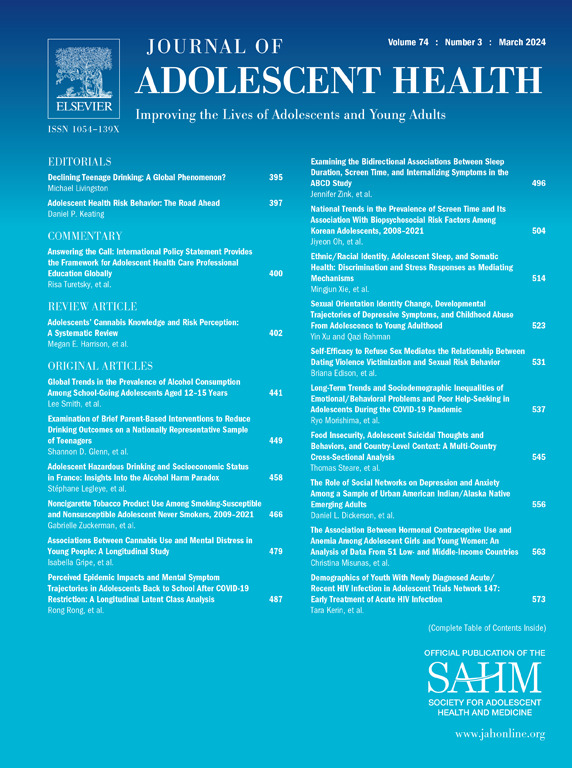识别1999年至2021年美国年轻成人死亡率变化的景观。
IF 4.5
2区 医学
Q1 PEDIATRICS
引用次数: 0
摘要
目的:评估1999年至2021年年轻人(18-39岁)死亡率的时间趋势和驱动因素。方法:观察性研究使用1999年至2021年具有全国代表性的美国死亡率数据,这些数据来自美国疾病控制中心流行病学研究广泛在线数据数据库。兴趣暴露是死因。主要结果是人口水平的死亡率和1999年至2021年的百分比增长。次要结局是病因特异性和亚组特异性(性别、种族、民族)死亡率和百分比增加。结果:从1999年到2021年,美国18-39岁的年轻人的年死亡率增加了54.1%(从1999年的每10万人113.4例死亡增加到2021年的每10万人174.7例死亡;Cochran-Armitage p < 0.0001)。在新冠肺炎之前,从1999年到2019年,年轻人的死亡率上升了10.8%,而美国总人口的死亡率上升了1.5%。从1999年到2021年,年轻人死亡率上升的主要原因是意外中毒和接触有毒物质。死亡率趋势因人口统计变量而异,美洲印第安人/阿拉斯加印第安人的死亡率显著上升。讨论:美国年轻人的过早死亡率正在上升。应该调整资源,以便更好地支持这一代人。本文章由计算机程序翻译,如有差异,请以英文原文为准。
Identifying the Changing Landscape of Younger Adult Mortality in the United States from 1999 to 2021
Purpose
To evaluate temporal trends and drivers of mortality among younger adults (aged 18–39), from 1999 to 2021.
Methods
Observational study using nationally representative United States mortality data from 1999 to 2021, acquired via the US Centers for Disease Control Wide-ranging Online Data for Epidemiologic Research database. Exposure of interest was cause of death. Primary outcomes were population-level mortality rates and percent increase from 1999 to 2021. Secondary outcomes were cause-specific and subgroup-specific (sex, race, ethnicity) mortality rates and percent increases.
Results
From 1999 to 2021, US younger adults aged 18–39 experienced a 54.1% increase in annual mortality (from 113.4 deaths per 100,000 in 1999 to 174.7 deaths per 100,000 in 2021; Cochran-Armitage p < .0001). Before COVID, from 1999 to 2019, younger adults experienced a 10.8% increase in mortality, compared to a 1.5% increase among the broader US population. The top driver of increased younger adult mortality, from 1999 through 2021, was accidental poisoning and exposure to noxious substances. Mortality trends varied by demographic variables with notable increases among American Indian/Alaskan Native Americans.
Discussion
US younger adults are suffering from rising premature mortality. Resources should be calibrated to better support this generation.
求助全文
通过发布文献求助,成功后即可免费获取论文全文。
去求助
来源期刊

Journal of Adolescent Health
医学-公共卫生、环境卫生与职业卫生
CiteScore
10.40
自引率
3.90%
发文量
526
审稿时长
46 days
期刊介绍:
The Journal of Adolescent Health is a scientific publication dedicated to enhancing the health and well-being of adolescents and young adults. Our Journal covers a broad range of research topics, spanning from the basic biological and behavioral sciences to public health and policy. We welcome a variety of contributions, including original research papers, concise reports, literature reviews, clinical case reports, opinion pieces, and letters to the editor. We encourage professionals from diverse disciplines such as Anthropology, Education, Ethics, Global Health, Health Services Research, Law, Medicine, Mental and Behavioral Health, Nursing, Nutrition, Psychology, Public Health and Policy, Social Work, Sociology, and Youth Development to share their expertise and contribute to our mission of promoting adolescent health. Moreover, we value the voices of young individuals, family and community members, and healthcare professionals, and encourage them to submit poetry, personal narratives, images, and other creative works that provide unique insights into the experiences of adolescents and young adults. By combining scientific peer-reviewed research with creative expressions, our Journal aims to create a comprehensive understanding of the challenges and opportunities in adolescent and young adult health.
 求助内容:
求助内容: 应助结果提醒方式:
应助结果提醒方式:


